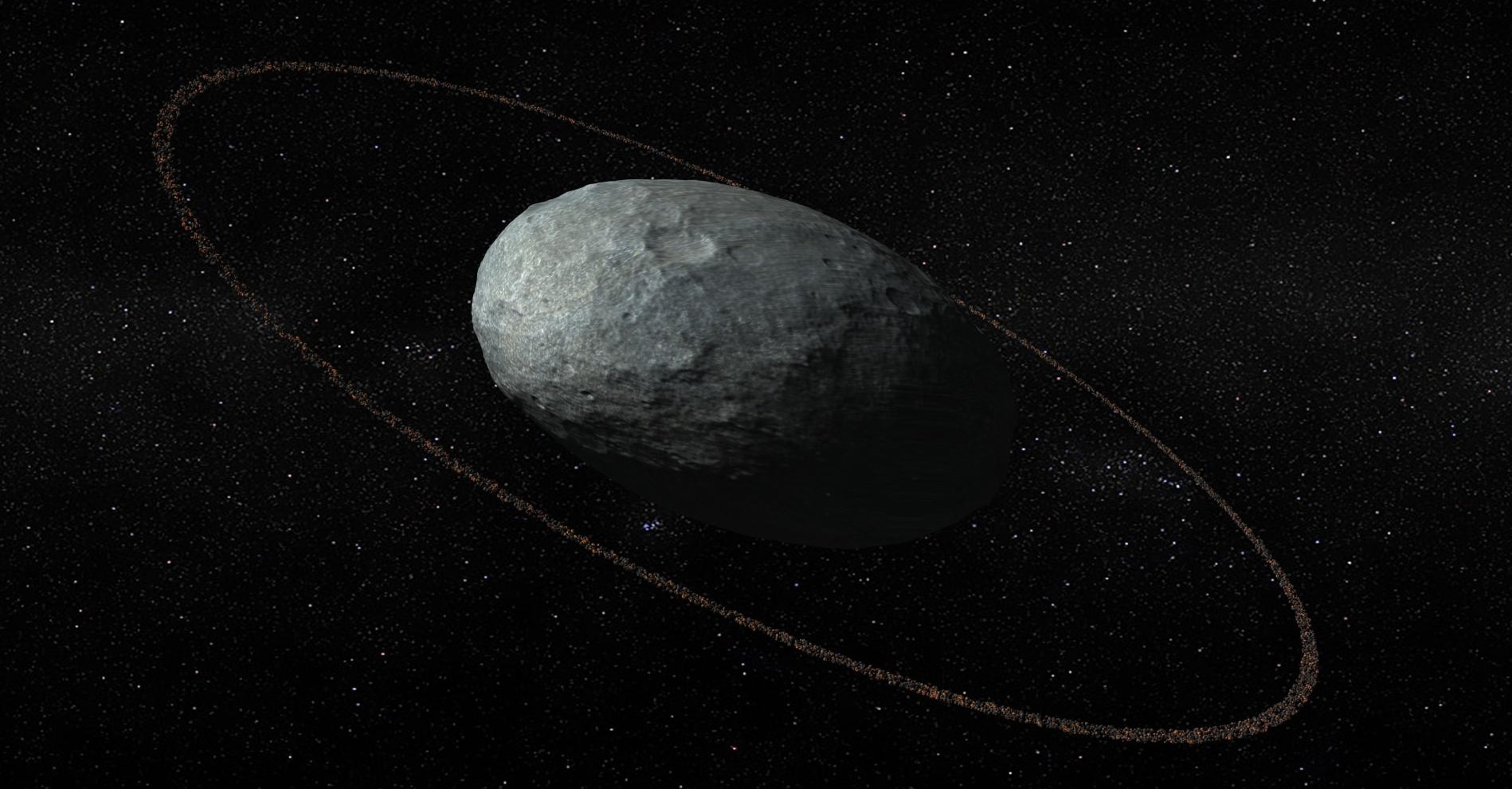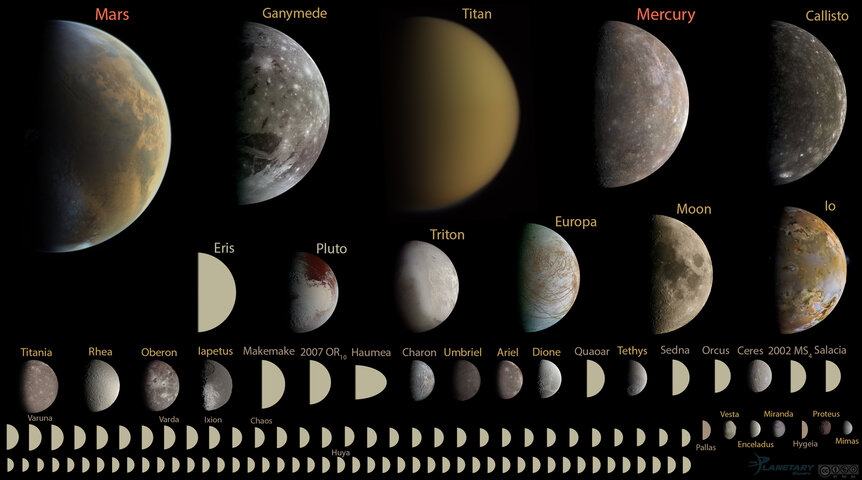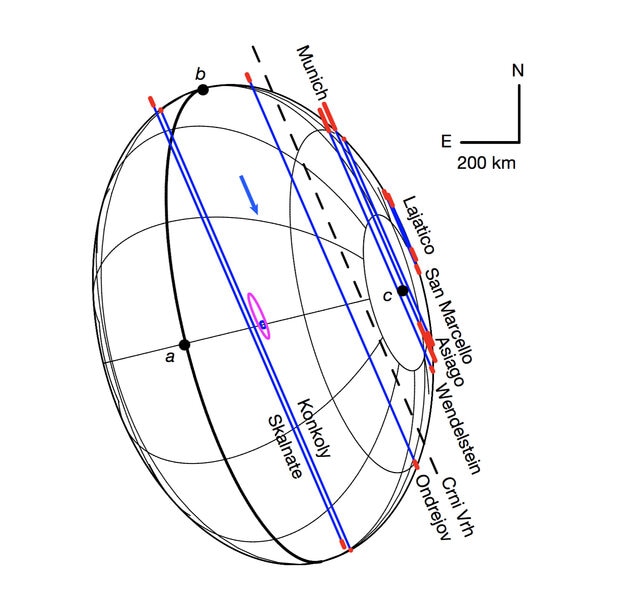Create a free profile to get unlimited access to exclusive videos, sweepstakes, and more!
A weird, distant potato-shaped world gets weirder: Haumea has rings!

Astronomers have just determined that the rock-and-ice worldlet Haumea is part of an increasingly less-exclusive club: solar system objects with rings.
Haumea is what we call a Trans-Neptunian Object; something orbits the Sun beyond the orbit of Neptune. This includes many trillions of bodies, most of which are rather small. Pluto is the biggest we know of, though Eris is very nearly the same size. Haumea is smaller than that but still one of the biggest TNOs known.
Its size is actually a little difficult to describe, because it’s not spherical. Far from it! It’s actually prolate, elongated like a rugby ball or an American football. But even then it’s not symmetric. Along its longest axis it’s a little over 2,300 km across, very nearly the same as Pluto. But it’s considerably flattened; through its shortest axis it’s only 1,025 km wide and 1,700 through its intermediate axis. Its shape is most like a flattened potato, about the only analogy I could think of.
So right off the bat this is a weird object.
When you think of rings you undoubtedly think of Saturn. If you have a little more inside astronomy info, you’ll know Jupiter and Uranus have rings, too, while Neptune has ringlet arcs, incomplete rings around it. And if you’re really in the know, you’ll remember that two Centaurs (icy bodies orbiting the Sun between Jupiter and Neptune) called Chariklo and Chiron have rings, too.
And now we know Haumea has rings too, the first TNO known to possess them. They were discovered on January 21, 2017. Some months before that astronomers projected Haumea’s orbital motion into the future and saw it would occult, or pass directly in front of, a distant background star. That means the starlight would drop as it’s blocked by Haumea. And that’s very important.
For one thing, occultations help astronomers figure out how big an object is: Knowing its motion and how long the star is blocked tells you how big the object is. If you observe it from different latitudes on Earth you can also get a rough shape for it, too; from different viewpoints the star cuts different chords behind the object, so an outline can be found. I described this in detail recently for another distant TNO, when MU69 occulted a star and it was found to be binary.
But there’s more. If you observe the object well before and after the main body occults the star, you might see other dips in starlight too. A moon could block it … or rings.
So a dozen observatories at 10 locations in Europe observed the occultation that night. The main event lasted about two minutes, but about a minute before and a minute after, dips were seen in the starlight. This is what you’d expect for a ring extending well outside the main body of Haumea. It can’t be two moons, one on either side, because the star’s light wasn’t completely blocked; it dropped by about 50%, so the blocking object isn’t solid.
It must therefore be a ring, composed of countless tiny particles.
The ring is about 70 km wide, and orbits directly over Haumea’s equator, with an orbital radius of about 1,145 kilometers.
So now that we know it exists, the question is why does it exist? How did it form?
We have clues. Haumea has two moons, and it’s thought that outer solar system objects with moons probably got them through collisions. Something big smacked into the TNO, blasting debris out, which coalesced to form the moons.
Several other smaller TNOs share similar orbits with Haumea, suggesting they all formed together and spread out over time; that’s consistent with a collision as well. Haumea itself rotates extremely rapidly, spinning once every 3.9 hours (that partially explains its weird shape — it’s due to rotational flattening). Normally, something Haumea’s size would spin far more slowly, so perhaps the impact was a little off-center, spinning Haumea up.
The rings would then be debris left over from that collision. They’re too close to the main body to coalesce to form a moon: The tidal force from the gravity of Haumea prevents them from clumping up.
But the formation of the rings is still unclear. We need a lot more observations to figure that out. The star that was occulted was rather faint, so big ‘scopes were needed to observe it at all. If a brighter star gets occulted then more information can be gleaned from the event. That could certainly help us understand what’s going on.
And the implication is interesting, too. If Haumea has rings, how many other TNOs do as well? From the New Horizons flyby we know Pluto doesn’t, but there are lots of big TNOs. Most have moons as well, so we know collisions happen. Haumea may be the first TNO found to have rings, but I’d bet significant cash it won’t be the last.






























